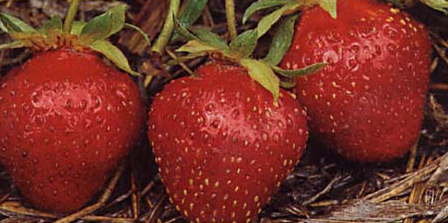Strawberries!

Strawberries ready to pick!
Why are we talking about strawberries in March? Because it is the perfect time to to plant! Planting bare root strawberry crowns while they are dormant is easy and economical. And, if you plant day-neutral varieties, you’ll get fruit this summer!
Strawberries prefer sandy, well drained soil and full sun. Remove all weeds, and work in
compost before planting. Plant dormant plants now through mid-spring. Trim the roots to 4″-5″, and set so that the crown is at soil level.
Strawberries need soil moisture to thrive. The most crucial times are before and
during harvest, and in late summer and early fall when June bearers are forming flower buds for next year’s fruit. Drip or soaker hose irrigation is preferred to avoid fruit rot. Control weeds to reduce competition in the bed.
Main Crop Varieties (June Bearers)
Main crop varieties should be planted 15″-24″ apart in rows spaced 36″-42″, and runners
allowed to fill the spaces between the plants to form a solid row 14″-18″ wide.
Remove the first season’s flowers by cutting or pinching them off. This will
encourage runner formation and good root establishment. Pin or peg the runners to
fill the row. Do not let plants root closer than 6″. Any runners that form after late
August should be removed. The second season, the plants can be allowed to bear a
full crop. After June bearers finish fruiting, cut or mow the leaves to stimulate vigorous
growth. Dig up and replant rooted runners to fill gaps in the rows. At this time,
lightly fertilize the bed.
Day Neutral Varieties (Everbearing)
Day neutral varieties should be planted 10″-18″ apart in rows spaced 30″-36″. In the closer spacing, remove all runners throughout the season; in wider plantings, allow one runner between each plant. Remove the first blossoms to encourage root development. Flowers appearing after mid-June can be allowed to form fruit. Fertilize day neutral varieties in late summer.
You can also grow day neutral varieties in pots. Use a good potting soil, and feed them regularly with a dilute liquid fertilizer.
Most strawberry varieties eventually become infected with viruses, and the bed must be renewed with new plantings, on average every 4-5 years. Some of the newer varieties such as Albion, Seascape, Charm and the Puget series, are more tolerant of the viruses and can usually produce longer.

